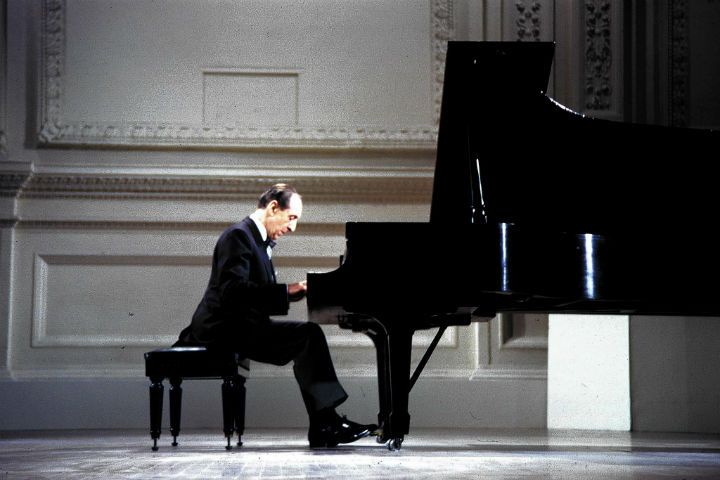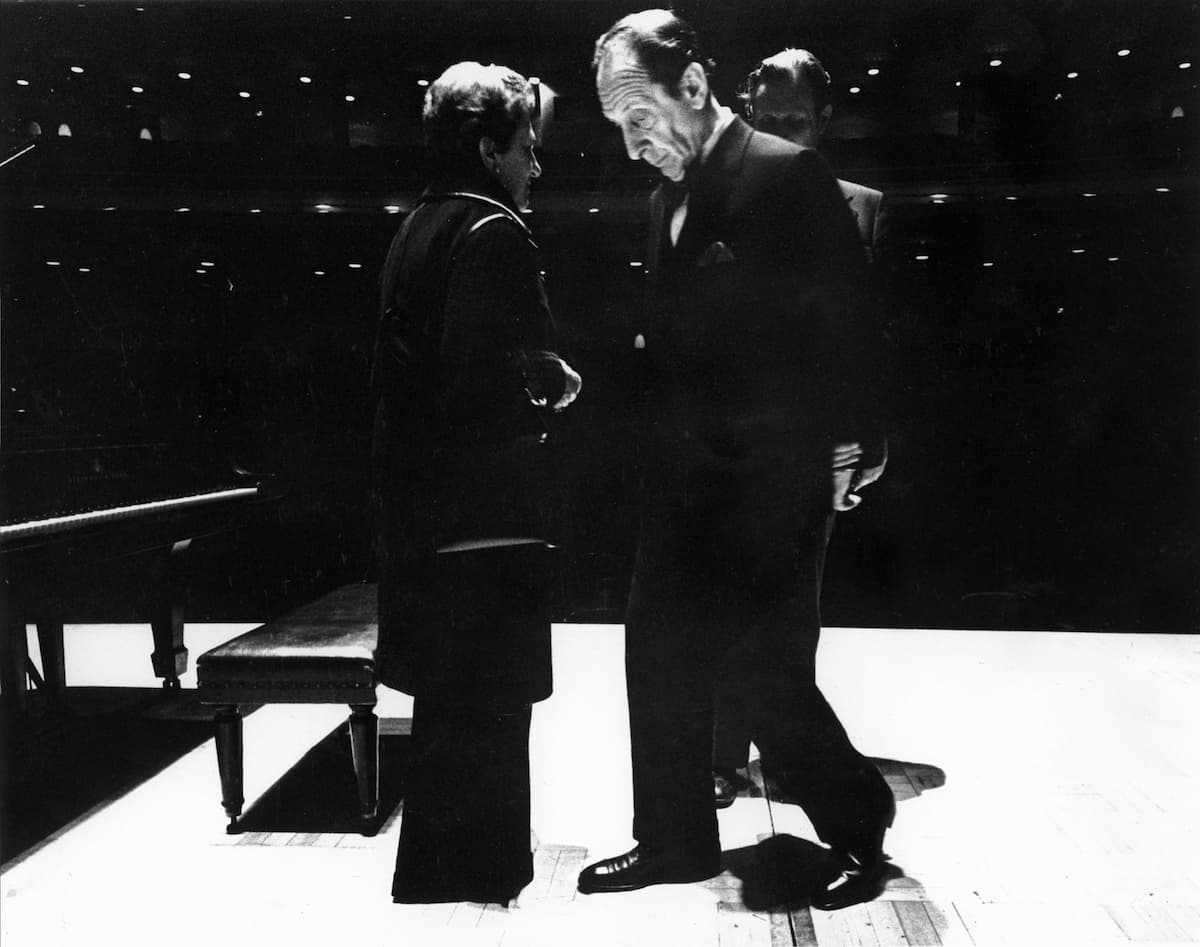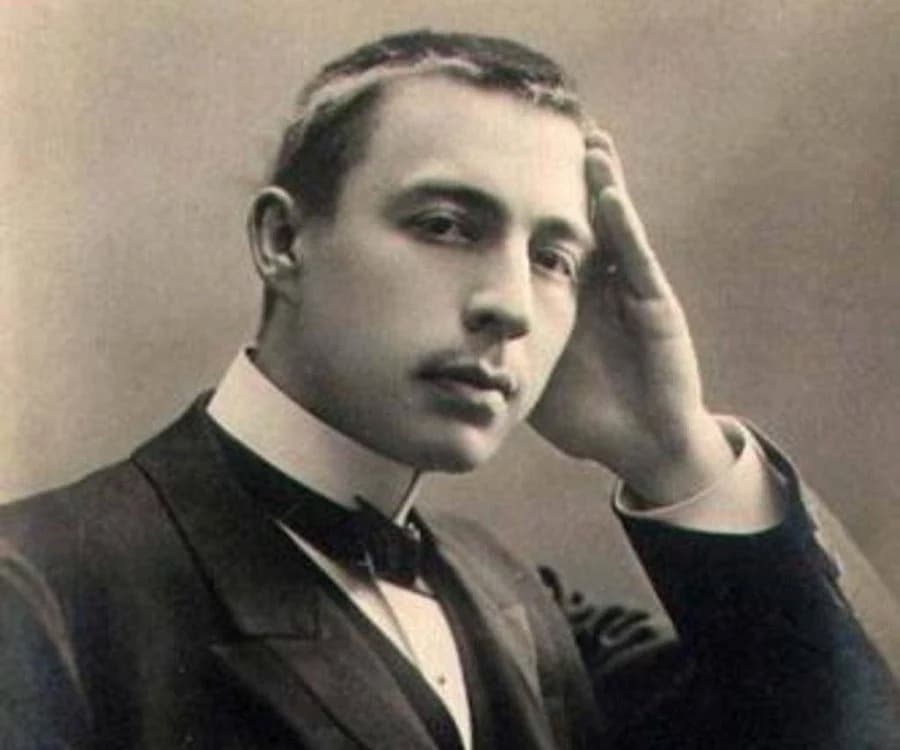The film Vladimir Horowitz: The Last Romantic begins with a shot of a frail elderly man in the back of a taxi. “Mr. Horowitz, you look very, very good,” a voice says offscreen.
Thirty seconds later, we cut to the old man playing a grand piano in a basement showroom. He plays with a power and pizzazz that you would never, ever have guessed him capable of.
“I remember everything,” he says with a twinkle in his eye.
Vladimir Horowitz – The Last Romantic
The Last Romantic was released in 1985, only four years before Horowitz’s death. It’s an unusual hybrid of genres: not quite a concert performance, but also not, strictly speaking, a documentary. It features a casual performance (if any Horowitz performance can be labeled casual…) that he recorded at his townhouse in New York with the help of his manager, his wife, and a team of recording engineers, interspersed with conversation about his life and work. It’s an invaluable peek into the life and personality of a legend.

Vladimir Horowitz at the Carnegie Hall concert in 1965
It’s currently available on Youtube free of charge, and I recently watched it for the first time. To whet your appetite, here are my top ten takeaways from the documentary, in no particular order of importance.
1. It’s fascinating to see a great pianist playing at home.
This documentary made me wonder: how often do most soloists actually give performances in their own homes, anyway? Of course, many make venues like Carnegie Hall or the Concertgebouw their musical homes and learn to adapt their playing to those halls. But it took me by surprise how moved I was to see Horowitz in this more intimate, domestic setting.
2. I love seeing closeups of a piano legend’s hands.
Things are different now, but in Horowitz’s day, it was difficult to film unobtrusively during a live performance, especially when there was an audience present. However, because there are only a handful of people here, the camera operator feels comfortable getting up close and personal and catches shots that you don’t see in many other concert films of the era. Watch 19:12 for an example of what I’m talking about. This isn’t just interesting from an aesthetic or cinematic point of view; it’s also interesting from the point of view of dissecting his technique, as well.
3. Wanda Horowitz was a smart and sassy fashion icon.

Vladimir and Wanda Horowitz
This film really emphasizes the role that legendary musical wife Wanda Horowitz (the daughter of Toscanini) played not only in Horowitz’s personal life but in his creative life, too. She is a constant presence, even when we don’t see her. When she does appear on camera, it’s a delight to witness her quips and elegant outfits.
4. Horowitz is so adorable when he’s childlike!
This happens a lot throughout the entire documentary. One of my favorite examples is at the beginning when Horowitz plays a Bach chorale prelude arranged for piano by Busoni. His playing shocks the breath out of you with its intensity, and you can hear the awed silence in the room as he finishes. Then, after he plays the final notes, he looks directly into the camera – and just beams. It’s such a sweet moment.
5. Was Wanda Horowitz really that intimidating of a figure – or were twentieth-century audiences just not used to unapologetic, no-nonsense women?
She had a reputation during Horowitz’s lifetime of being overbearing or even shrewish. But in this documentary, she’s never rude (with the possible exception of an exasperated eye roll when her husband gets silly at the 12:48 mark). She is, however, always very direct…and it seems that, at least by this point of his life, Horowitz deeply appreciates that! Seeing this film, and the candid video of Wanda interacting with her husband, made me rethink all of the legends I’d heard about her.
6. His grief over losing his legendary musical friends is heartbreaking.
At 11:05, while sitting on his sofa with Wanda and discussing the olden days, he grows abstracted and shakes his head. “It’s terrible,” he says of his departed colleagues. “They’re all dead. When I look over – all dead. I knew all of them.”
7. The greater the musician, the more irrelevant their instrument becomes.
I’ve thought about this for a long time, but this documentary really hammers the idea home. You can see so clearly how the musical ideas are in Horowitz’s head and heart and hands, and the piano just happens to be the medium through which he is most comfortable expressing them. At times I forgot the piano altogether, hearing nothing except phrasing and subtleties and musical narrative. So few artists reach that plane of accomplishment.
8. Wanda would listen to her husband practicing from their staircase.
In order to fairly assess the quality of his playing, she felt she had to be in the next room over. Otherwise, she says, if she was too close and could actually see him, she’d feel too vulnerable to the magnetic spell of his playing.
9. Horowitz absolutely adored Rachmaninoff.

The Young Rachmaninoff
At one point, he points out to the film crew some pictures on his wall, including one of Rachmaninoff and one of his father-in-law Toscanini. The interviewer asks the loaded question: “Who was your favorite?” “These two,” Horowitz hedges. Wanda, blunt as ever, admonishes him: “Don’t be afraid. Say Rachmaninoff.” Finally, Horowitz gives in and tells the truth, saying, “Rachmaninoff is a pianist… People say, what a nice pianist, and nice friend. He was my best friend. First of all, he was a composer, pianist, and conductor. Three things at once. And first class all three.” Wanda, completely unbothered by her father being sidelined, agrees: “And he was a wonderful person. There was a man in the grand style.”
10. The way he hammers the piano during the Chopin Polonaise is absolutely thrilling.
Despite his age and seeming frailty or even childlikeness, Horowitz’s energy is just overpowering. You can tell that this is a person who is used to playing massive halls, not townhouse living rooms. The beginning of the ending of this rip-roaring finale is around the 1:20:20 mark. “Like old days, Jack,” he says when he’s finished, and he sticks out his tongue in delight.
I loved this documentary, and I hope all classical music lovers will put it on their to-watch list. I came away with a fresh appreciation not only for Horowitz’s playing, but for his personality and the people around him who supported his career and made it all possible. We are so fortunate it was made and is still available to enjoy today.
For more of the best in classical music, sign up for our E-Newsletter



